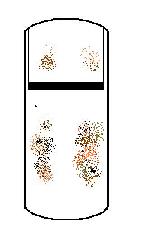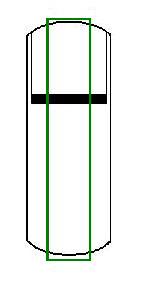


Home |
|
Index
Stuff Other Tools Forms Rebuilding Taper info |
| You're
standing
there with a Stanley 9½ block plane in your hand.
You've picked it out from among a pile of other used tools.
It's
price tag is $15. Your hand is itching. The wallet in
your
hip pocket feels heavy. Do you buy this poor abused fellow
or walk
away, sadder but wiser?
Buying a used plane can be an emotional experience. There's just something about used tools that cry out "Save me! Save me!" The problem is, how do you tell the true bargains from the real junk. Today collectors have driven up the price of most older Stanley 9½ block planes that are in good, very good, or excellent condition. Those planes will bring as much as, or more then, a new plane. It's a fact. Most planes that are sold in a flea market are in less then good shape. Doesn't mean they're to be avoided. It just means that you need to be a little selective. For the most part a used block plane for $20 or less is a bargain. I've never come across one that I couldn't bring back from the dead. That doesn't mean that you should buy any or every block plane in sight. There are some thing you need to consider before you decide you want to invest the TIME in this particular plane. Of course, that's what this is. You're replacing money with time. If you're into the "Zin of rod building," time may be something you want to spend on something you enjoy. If not then you may want to look elsewhere. |
 Where
to
start? I don't worry about rust unless it's attacked any of
the
moving parts. Rust is one of the easier problems to deal
with. Do
check the pitting that rust usually brings. Pitting isn't
usually
a problme when flattening a sole, unless it's excessive and around
the
mouth of the plane. You'll end up with a flat and shiney sole with
a few
imperfections in it. Where
to
start? I don't worry about rust unless it's attacked any of
the
moving parts. Rust is one of the easier problems to deal
with. Do
check the pitting that rust usually brings. Pitting isn't
usually
a problme when flattening a sole, unless it's excessive and around
the
mouth of the plane. You'll end up with a flat and shiney sole with
a few
imperfections in it.
Scars along the side of the body make the plane less valuable to a collector, but don't affect function. (I have one plane that looks like it was attacked by an arc welder. it has a 1/16 in scar down one side, destroying it's collectable value. It cost me about $12). Look at the plane. Is it all there? If not, do you
want
to spend the time (or money) replacing missing parts. Is
it working?
By this I mean can you adjust it and will it stay
adjusted. That
means check all the moving parts, the toe, the lateral
adjustment bar,
the wheel that adjusts the blade. While your at it make
sure the
blade makes contact with the arm that will move it in and
out. How
is the blade held under the cap? Almost every block plane
ever built
has a quick release lever on the upper end of the cap. (I
have one
plane that had this lever broken off. I replaced the
device with
a 1/4 hex screw.) How much travel does the toe have?
If it's
stuck, I try to take off the adjustment screw and remove the toe
from the
plane body. If I can get it free, I examine the
inside for
problems. The area that makes contact with the toe should
be smooth
and free of obstructions. How far will the throat
close? Will
it hold it's position. Is the Eccentric toe adjustment
lever there?
(I bought a plane without the toe adjustment lever and
replaced it
with a washer that I filed to a concentric shape. It
works.)
|
| Once I've decided that the parts are all there (or I can replace
them)
and that the plane is in working mechanical order, I turn it over
and look
at the sole.
The adjustable toe should be flush with the rest of the sole of the plane. More then a thousandth above or below the sole means something's wrong and will take special consideration. |
| I look at the general condition of
the sole.
It will probably be scared. This may or may not be a
problem.
The area we're interested in is the area in the Green
rectangle.
That's the part of the sole that will be touching the
bamboo. Anything
outside of that area will be resting on top of the planing
form.
As long as it's flat it can be scarred, chipped or
scratched.
If, on the other hand, the area inside the green rectangle is scarred, chipped or scratched. I'll want to look very closely at the extent of the damage. The scars on the sole of most block planes run in the direction of movement, vertically as we look at the sole of this plane. |
 |

Home |
Think about these a
while
Back to the TOC |